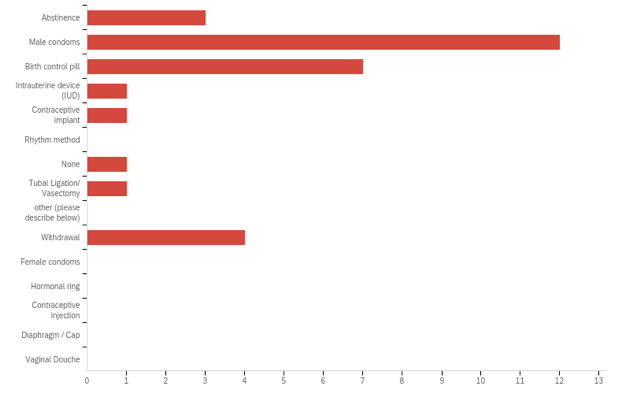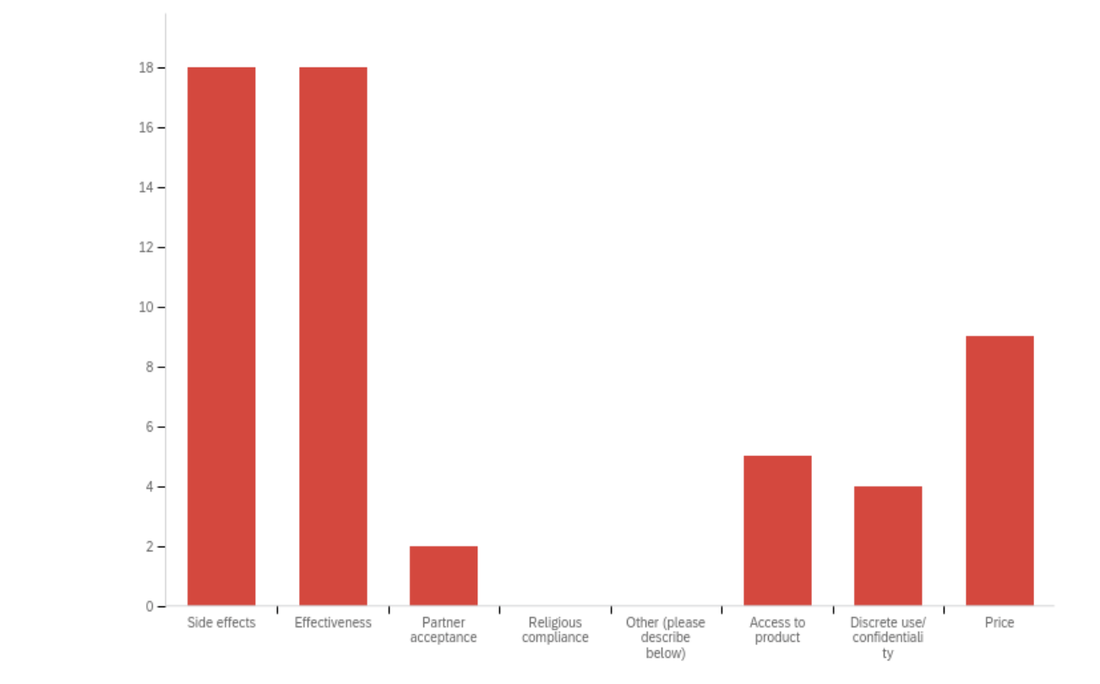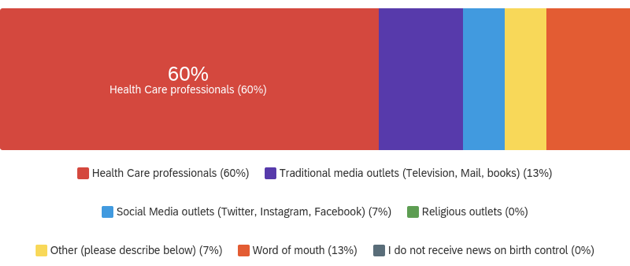|
Survey developed, conducted, and reported on by Edward Morris, Male Contraceptive Initiative Intern This survey was distributed through university students at a Southern US university (n=20, with 19 respondents completing the entire survey). Recruitment was done through a student group and other personal relationships and is not representative of any population. The aim of this survey was to understand the perceptions that this group of African American women have about potential future male contraceptive methods, and how their experiences with female contraception may potentially inform their perception of male methods. A secondary goal was to help inform future marketing efforts by understanding where participants get information on contraception and how they respond to that information. Respondents were all African American women. Most (13) were university seniors, two were juniors, and two were sophomores. One was a community member. Most respondents were 18-24, and one was 35-44. 18 were heterosexual, with one preferring not to say. A majority of respondents (55%) agreed with the statement that they trusted their partner to be responsible for family planning, and 53% already use a male method of contraception (in this case, condoms and withdrawal). 65% and 75%, respectively, said they would potentially trust their partner to use a male pill or male long-acting reversible contraception (LARC; Figure 1). Based on these responses showing that many participants are already using methods of male contraception, and levels of potential trust in a male partner using a method is high, we can extrapolate that most participants would be open to their partner using new methods of male contraception. Figure 1: Measure of respondents who would trust their partner if he were to use a LARC Figure 2: Measure of what birth control respondents and their partners currently use Some respondents (10) said that there would be factors that would convince them to use male contraception. These factors included people in their community using it, partner sharing responsibility, that future methods are easy, safe, reliable, affordable, comfortable, efficient and effective, and how often the method needs to be used. When choosing their own birth control, the respondents listed many important factors, including side effects (18 mentions), effectiveness (18 mentions), price (9 mentions), and access (5 mentions) (Figure 3). It’s reasonable to assume that respondents would look for similar characteristics in their male partners’ methods in the future, or that male users themselves would prioritize similar characteristics. Figure 3: Important factors when selecting birth control for oneself Respondents also mentioned company reputation (84%) and historical contraception programs such as eugenics and population suppression programs (53%) as factors that they consider when selecting birth control. These points indicate that future marketing, and engagement with companies and dissemination efforts, should be done with input and buy-in from potential users, particularly African Americans and other historically underserved populations. This would be a valuable step to promote trust, engagement, and successful uptake of future methods. Respondents listed barriers that men may encounter when trying to access future methods (Figure 4). 16 of 19 respondents listed stigma as a barrier, followed by side effects and availability mentioned by 11 and 10 respondents, respectively. Respondents also listed price (6), female partner (6), gender discrimination (4), access to services (3), racial discrimination (2), and providers only wanting to provide certain methods (1) as potential barriers. In order to make future male methods accessible and appealing to users, it will be important to proactively address potential stigma and accessibility limitations. It will also be important to ensure that the side effect profiles of products are minimal and that users have realistic expectations of side effects. Figure 4: Measure of participants’ perception of barriers to future men accessing contraception In addition to their perceptions on birth control, participants were asked about their thoughts on and experiences with receiving information about birth control (Figure 5). Most respondents (15) do not look for news on birth control. When they did get information on new forms of birth control, most of them (17) received it from health care providers, followed by TV (8), and friends and family (5). Two people cited internet sources, specifically Google and YouTube ads, and one each cited magazines/books, Twitter, and Instagram. Participants indicated a preference to obtain information about contraception from health care professionals (18), traditional media (4), word of mouth (4), social media (2), with two people wanting to get information from credible sources via Google, and the internet (Figure 5). Figure 5: Sources of information about new forms of contraception Figure 6: Respondents’ preferences on where to get news on birth control innovation This survey provides an important initial perspective on male contraception from a historically underrepresented population. Results from this activity will assist MCI and the male contraceptive R&D community in understanding the perspectives of female partners of potential users of male contraception, and also provide insights into how current contraceptive users select and access information about their methods. The results will also allow the male contraceptive research community to advocate for additional, more in-depth user engagement studies to promote successful introduction and uptake of male contraceptive methods as they become available.
Comments are closed.
|
Categories
All
Archives
June 2024
|
|
|
Donate to Male Contraceptive InitiativeYour generous donation makes a difference!
|
© Male Contraceptive Initiative. All rights reserved.








 RSS Feed
RSS Feed
